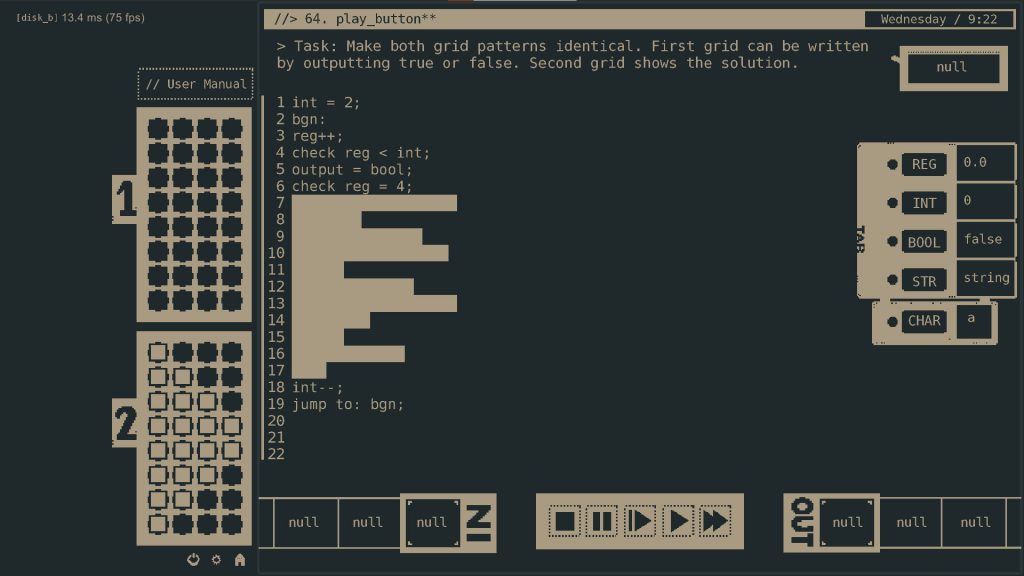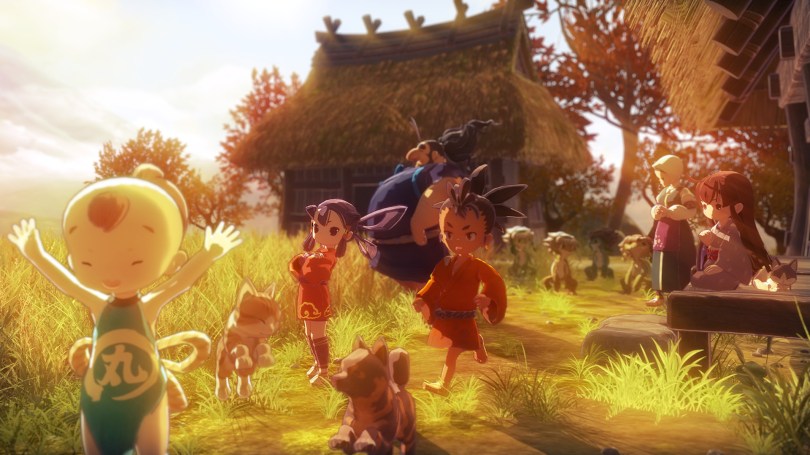
Name: Sakuna of Rice and Ruin
Genre: Farming Simulator/Hack and Slash
Publisher: XSEED/Marvelous
Platforms: Nintendo Switch, PlayStation 4, and PC
If I were to describe Sakuna of Rice and Ruin in a nutshell, it would be a mix of a rice farming simulator with hack and slash gameplay flavored with some (fictional) Japanese mythology. It’s no accident I started with the rice farming part first since, rather than being a minigame, it will be one of your main activities in the game and incidentally also how you will level up your character.
You play as Sakuna, a rather spoiled and bratty goddess who resides in the other gods’ lofty realm. There she spends most of her time eating and drinking while riding her parents’ coat-tails. When humans accidentally end up in the lofty realm, partly due to Sakuna’s negligence, her attempt to capture them destroys the rice warehouse of the gods. As punishment Sakuna gets banished to her a demon-infested island together with the troublesome mortals. She’s tasked to cultivate the land and rid it of an infestation of demons to make amends, while the mismatched group of humans supports her in varying ways.
The homestead you eventually arrive at will be your home base. Here you can upgrade gear, get side quests, eat and sleep, and of course, grow rice. Rather than just providing a subsistence source, growing rice is, like I mentioned before, how you level up Sakuna rather than traditional grinding through combat. The methods and care you use to grow your crops determine how (you can focus on particular stats) and how much your stats grow. The entire rice growing process is a deep, lengthy, and occasionally tedious process. As you progress through the story, more elements will be added, simplifying the process or adding more permutations to it. You don’t necessarily have to deal with everything yourself. For most steps, you have the option of letting someone else take care of it at the cost of less effective returns. You can also change the difficulty of the rice farming aspect in the game’s menu entirely.
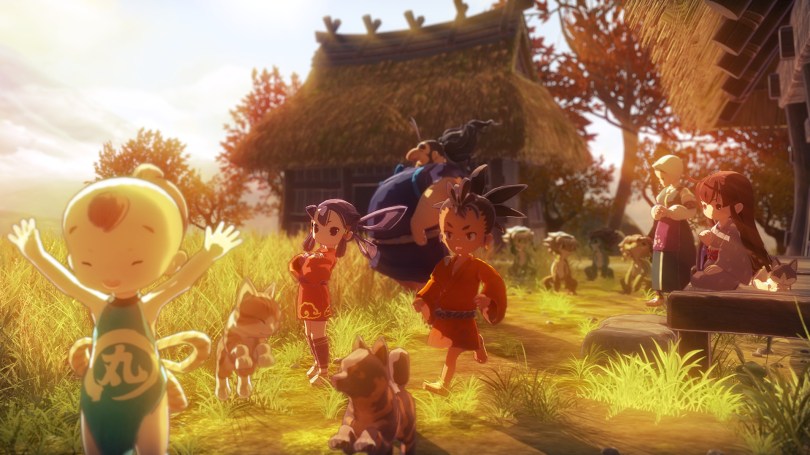
Here’s to give you an idea about what the rice farming portion of the game is about: you have to level the field, sort seeds, seed them, make fertilizer, remove weeds, manage water levels, harvest, dry, and process your crops. OK, perhaps that’s more than just giving you an idea. Once you have harvested your crops, there are still several steps you have to take to turn it into rice, and how long you spend on them will determine what kind of rice you will turn up with. For example, getting white rice requires the most processing and yields the most character growth. The last step, in particular, can be quite tedious, as it requires a lot of button mashing. Thankfully by repeating certain actions, you’ll unlock perks, like being able to plant 2 rice seeds at once, and as the story progresses, you may be able to build tools to make activities easier. The seasons will pass from spring to winter, which will affect the weather and adds additional time pressure to make sure you get the harvest in before winter sets in. Oh, and don’t get me started on how many customization options there are for making fertilizer. Also, don’t ask where you get the base components from. It’s better you find that out for yourself.
Once you leave your home base, you’ll enter the map screen where you can access combat areas infested by demons who mostly look like animals shaped like rabbits or pigs with weapons. You can gather cooking ingredients, crafting resources, and the occasional gear and upgrades by venturing into these areas. Some areas are even devoid of enemies and have you gather resources. You can also send your comrades to gather resources at particular gather areas, though they will disappear from your home base until they’re finished. By clearing these areas, usually by reaching the exit or beating an enemy ambush or occasional boss, you’ll raise your exploration level, which in turn unlocks new areas. Each area also has optional objectives, such as beating a set amount enemies at night, beat a boss with a time limit, or find a particular item. These optional objectives can further boost your exploration rate.
Combat:
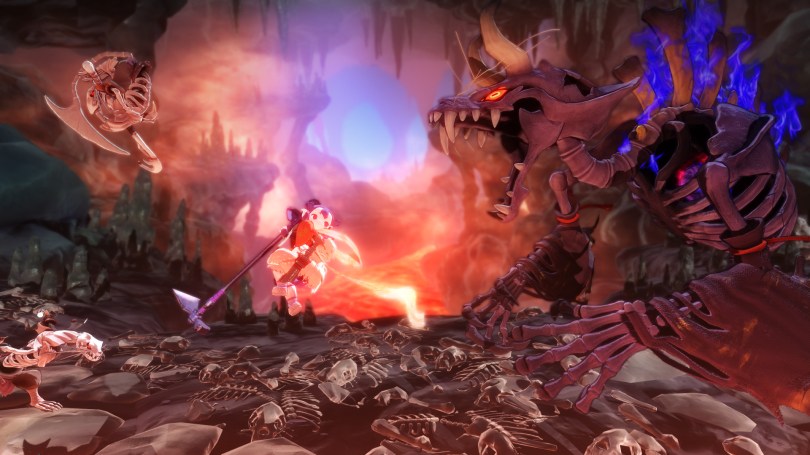
Combat comes in the form of 2D hack ‘n slash gameplay, where you utilize your 1 handed and 2 handed weapons for light and heavy attacks, respectively. You can also use special attacks for more damage, though they consume energy from a recharging gauge. You can unlock more special attacks to map to your special attack buttons as you progress, and they’ll level up as you use them. Another tool you will use a lot is your sash, which can pull yourself to enemies or reach platforms out of reach of your normal jump. Using your sash to get away from enemies dogpiling on you is often key to survival. Similarly to your special attacks, you can also unlock special moves for your sash and equip them to one of 4 available slots. Unfortunately, I did find these moves to be rather tedious to pull off.
You’ll mostly rely on crafting to get more powerful weapons and gear with certain bonuses (sometimes even ones tied to a particular season). Each piece of equipment also comes with slots to equip certain bonuses, though some are locked until you meet particular conditions like beating a certain amount of enemies. On another note, equipped gear can affect your character’s appearance, which is a nice touch.
Changing seasons will change these areas’ aesthetics, but it’s when it gets dark that gameplay is drastically affected. Not only does the darkness severely reduces visibility, but it also makes enemies that much tougher. Depending on your level and weapon strength, you’ll likely barely chip away at their health, so it’s usually a good idea to head home at this point. Sakuna will, as time passes, also get hungry, which will prevent her from self-healing and removes any food buffs you may have received from a prior meal. Again the best solution is to hurry on home to eat and sleep until the next day. Occasionally you will find yourself in need of a particular food buff such as poison resistance to progress through a certain area, so some care in assembling your menu should be taken. Note that food ingredients can spoil, though it can be somewhat mitigated by turning them into preserved food items.
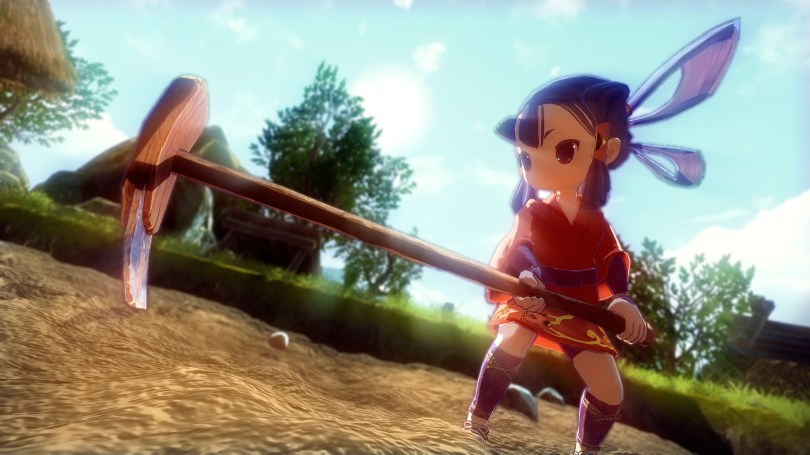
So how do all these gameplay mechanics mesh together? Well, mostly quite well. There’s a certain flow where you start by managing your field, then leave to beat up some demons to increase your exploration rate and gather resources, and eventually return home to fuel up and nap until the next day. That being said, the game could be tedious and somewhat repetitive. While you will get more options for growing your crops as you go along, you may find the sheer number of variables overwhelming. The exploration portion of the game doesn’t have a lot of variation in it, and it can sometimes be unclear if you need to explore more or wait for the story to progress for you to continue. Combat in particular, despite an attempt to add some depth to it, may often end up with you button-mashing or spamming the same special attack over and over again. Enemies can be challenging, but this mostly lies in how spongy they can be or their sheer numbers. The game does offer players to lower the difficulty of both the farming and combat sections separately. I’m expecting plenty of players to lower the combat’s difficulty at some point, to save themselves the tedium of dealing with this never-ending supply of enemies.
Art Style:
As for presentation, the game uses a cell-shaded graphic style with anime like character designs. The character designs are quite interesting, and there are some pretty looking locales, though most of the areas you encounter are your typical caverns with little variety in between. There’s some nice variation in enemy types, though. I can say that the Japanese voice acting is pretty good concerning the audio, and I particularly enjoy Sakuna’s bashful personality. Sadly the English voice track is rather atrocious, so I avoided it like the plague. The soundtrack is great, too, with enjoyable tunes filled with typical Japanese sounds. The lip-sync is all over the place, though, but it didn’t really bother me most of the time. I did find the game going at an incredibly slow pace narrative-wise. Also, I can’t really say I liked most of the other farm inhabitants, aside from Sakuna, but that may be up to personal taste to a certain agreement.
Verdict:
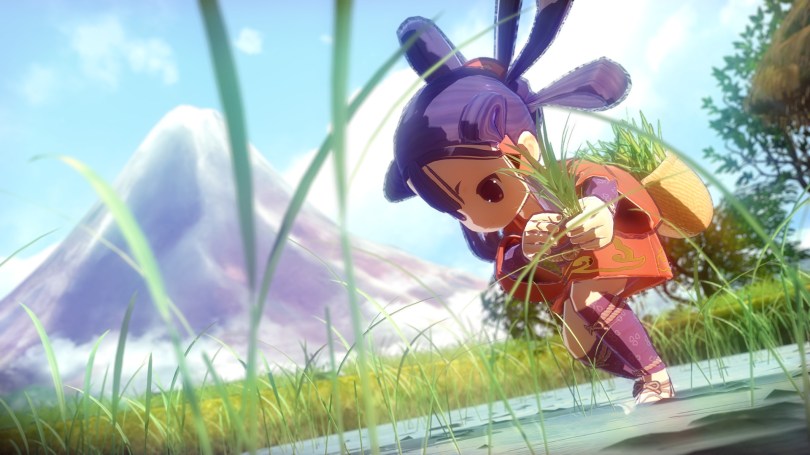
I’ve said this before in the preview, but above all else, Sakuna of Rice and Ruin is a love letter to traditional Japanese rice farming. In a way, it’s a refreshing title for trying to combine a simulator type game with hack and slash gameplay. Yet it is bogged down by the tedium and repetitiveness of both parts of the game. Aesthetically it’s quite pleasing, and Sakuna is a great character, but be aware it’s going at its own pace for better or worse. On the plus side, the game is surprisingly lengthy. Also, I don’t recall experiencing any bugs or performance issues.
7/10

